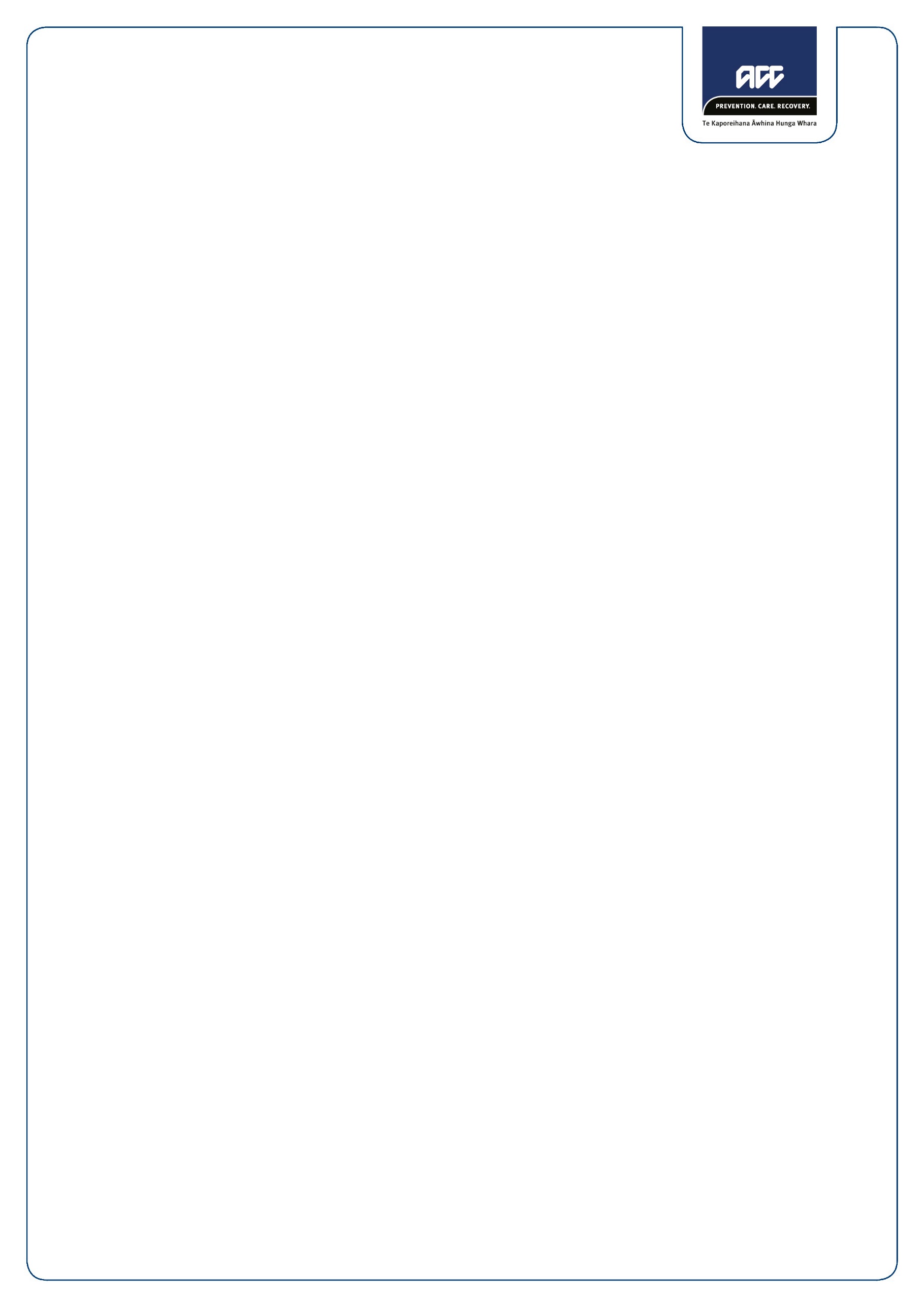
09 April 2020
Valerie Markham
[FYI request #12280 email]
Tēnā koe Valerie
Your Official Information Act request, reference: GOV-003888
Thank you for your email of 20 February 2020, asking for the following information under the Official
Information Act 1982 (the Act):
1) When was the ACC Partnership Programme (ACCPP) introduced ?
2) How has the reported incidence of Occupational Overuse Syndrome (OOS) been affected each
year since the introduction of ACCPP? Official statistics please.
3) How many reports of OOS to ACC each year in the 5 years prior to the introduction of ACCPP?
Official statistics please.
4) How many private companies/organisations/industries have joined with ACC each year since
introduction of ACCPP.? Stats ?
5 a) Are any of the above Multi-national corporations/companies?
b) How many ?
6) What types of companies/organisations/industries are they? E.g Cleaners? Tech.?private
hospital workers?
7) Currently (2019-2020) what is the prevalence of OOS in NZ?
8) If compensation is awarded, what is the average time/period of compensation/ payment for
OOS treatment since introduction of ACCPP?
9) Does this average time period of treatment or average amount of monetary compensation
compare with the period and/or monetary compensation awarded in the 5 years prior to ACCPP?
10) How many claims each year for compensation for OOS have come before the Courts since
introduction of ACCPP?
11) Is there any permission or evidence for Unions' (e.g. E tu) intervention or participation in
claims made to private companies/etc for OOS.?
12) Who/which (govt organisation) is responsible for the annual auditing of ACCPP companies?
13) Is this audit monetary only or is there also utilisation of medical/treatment criteria? (Ref; 8,
9, 10 above)
14) Have there been any reductions or restrictions made to the waived 90% tax levy to
companies/etc as penalties for failure to appropriately manage claims/compensation?
On 28 February 2020, ACC emailed you to refine your request. The same day, you confirmed the
following:
Please send to me the information relating to my previous request dating back to 2010 as
indicated in your response.
For ease of reference, we have grouped questions two, three, seven, eight and nine together in our
response.
Question 1 - When was the ACC Partnership Programme (ACCPP) introduced?
The ACC Partnership Programme, now known as the Accredited Employer Programme (AEP), was
introduced on 1 July 2000.

GOV-003888
Question 4 - How many private companies/organisations/industries have joined with ACC each year
since introduction of ACCPP?
Table 1 below provides a count of total AEP contracts held with ACC, dating back to March 2010. Each
AEP contract covers a group of employers (also known as legal entities). The Accredited Employer
Framework allows employers to enter the AEP as a “group”. Groups can be comprised of employers that
are subsidiaries of the same holding company. The AEP contract is recorded at a group level rather than
an individual subsidiary company level. As such, information is provided at group level.
The data in Table 1 has been extracted by ACC levy year (1 April to 31 March). The Total AEP contracts
are a count of the total number of AEP contracts in each year. The New AEP contracts are a count of AEP
contracts that started in each year.
Table 1. Count of AEP contracts year ending 31 March
Date
Total AEP contracts New AEP contracts
2010
136
0
2011
134
4
2012
148
14
2013
140
2
2014
138
1
2015
140
2
2016
137
1
2017
139
2
2018
141
7
2019
138
2
2020
141
5
Question 5 - Are any of the above Multi-national corporations/companies? How many?
ACC is unable to advise how many of the above contracts are for multinational corporations/companies
as ACC does not hold information to this level of detail about participating AEP employers. ACC does not
require this information because it is not relevant to determine whether an employer is eligible to join
the AEP programme. Therefore, we are declining this part of your request under section 18(g) of the Act.
Question 6 - What types of companies/organisations/industries are they? E.g Cleaners? Tech? private
hospital workers?
For question 6, please refer to the data attached. The data provided is a list of all the Classification Units
(CU) and CU descriptions, that are included in at least one AEP contract, in the given year.
Please note that each AEP contract covers multiple companies and each company can have a different
CU. Likewise, multiple companies under the same AEP contract may have the same CU.
Accident Compensation Corporation
Page 2 of 5

GOV-003888
Classification Units
Every business and self-employed individual is assigned an ACC CU based on their business industry
classification code (BIC). A BIC code is chosen when a business registers for GST.
ACC groups similar businesses and self-employed individuals this way to make sure that levies are fair,
and to ensure that the costs of claims are shared fairly among the industries responsible for those costs.
Question 10 - How many claims each year for compensation for OOS have come before the Courts
since introduction of ACCPP?
ACC records the outcome of accident compensation appeals decided in the District Court by issue rather
than by injury. Furthermore, the term Occupational Overuse Syndrome (OOS) is not a recognised clinical
diagnosis.
Due to the above, ACC has no way of identifying whether a Court decision was in relation to an OOS
claim without manually reading through each individual relevant file, dating back to 2010 (of which
there are hundreds). Therefore, we are declining this part of your request under section 18(f) of the Act.
Please note that all appeal decisions (District Court, High Court and Court of Appeal) are publicly
available, either through the Ministry of Justice her
e www.justice.govt.nz/tribunals/accident-
compensation/decisions/ or the Otago University link provided on the ACC website here
www.acc.co.nz.
Question 11 - Is there any permission or evidence for Unions' (e.g. E tu) intervention or participation
in claims made to private companies/etc for OOS?
Employers in AEP must give unions and employee representatives opportunities to be involved in health
and safety, injury and claims management. This is mandated by the legislation, framework, audit
standards, contract and application form declarations.
Question 12 - Who/which (govt organisation) is responsible for the annual auditing of ACCPP
companies?
ACC is responsible for the annual audit of accredited employers.
Question 13 - Is this audit monetary only or is there also utilisation of medical/treatment criteria?
The annual audit provides a snapshot of the ability for an organisation to meet the requirements of AEP.
It is the ongoing responsibility of the employer to monitor and evaluate injury prevention and injury
management performance in the workplace, to ensure that the minimum entry-level audit standards
are maintained. The audit does not review the cost of claims or period of weekly compensation.
The audit standard is publicly available here:
www.acc.co.nz/assets/business/acc440-aep-audit.pdf.
Page 2,
What the audit standards do,
provides further information about the purpose of the audit
standards.
Question 14 - Have there been any reductions or restrictions made to the waived 90% tax levy to
companies/etc as penalties for failure to appropriately manage claims/compensation?
In return for taking on the financial risk, an employer could potentially have their ACC levy reduced by
up to 90%. Acceptance into the AEP does not automatically guarantee the ful 90% levy reduction.
Employers who meet the eligibility criteria for being in the AEP receive a levy reduction based on their
classification unit.
Up until 1 July 2019, employers in the AEP were entitled to a safety management discount based on
their level of achievement, i.e. whether they were at primary, secondary or tertiary level.
Accident Compensation Corporation
Page 3 of 5

GOV-003888
In situations where ACC determines that the accredited employer no longer meets the eligibility criteria
to continue in AEP, ACC has terminated the accredited employer contract.
Questions 2, 3, 7, 8, and 9
2. How has the reported incidence of Occupational Overuse Syndrome (OOS) been affected each
year since the introduction of ACCPP? Official statistics please.
3. How many reports of OOS to ACC each year in the 5 years prior to the introduction of ACCPP?
Official statistics please.
7. Currently (2019-2020) what is the prevalence of OOS in NZ?
8. If compensation is awarded, what is the average time/period of compensation/ payment for OOS
treatment since introduction of ACCPP?
9. Does this average time period of treatment or average amount of monetary compensation
compare with the period and/or monetary compensation awarded in the 5 years prior to ACCPP?
As per your email of 28 February 2020, we are only providing you with statistics related to OOS claims
from 2010 onwards. As such, we are not providing data relevant to questions three and nine of your
request, as these are asking for data in the five years prior to the introduction of the AEP.
Notes about the data provided
Table 2 provides the data relevant to the remainder of your questions regarding OOS statistics, from
2010 onwards. The data has been extracted for all work-related claims, lodged through an accredited
employer, between 2010 and 2020 where the injury is defined as OOS. The data was extracted on 11
March 2020 and may differ if re-run at a later date.
New claims
New claims are counted by the date they are lodged with ACC. This may be immediately after an injury
or at a later date.
Defining OOS
For the purposes of responding to this request, we have defined “OOS” as any accepted claim where:
• the fund account is the work account, or the claim is recorded as
work-related; and
• the accident scene is: farm; industrial place; commercial or service location; and
• the injury site is: head; back; finger/thumb; hand/wrist; elbow; upper arm; shoulder; chest;
knee; ankle; foot; back or in multiple locations; and
• the injury diagnosis is Gradual Onset (not disease/infection).
As there is no diagnosis that covers all and only occupational overuse syndrome, it is likely that the some
OOS claims may be missed and some non-OOS related claims are included in the data. As such, the data
provided should only be considered indicative of the total number of OOS claims that have been lodged
through an accredited employer in the period covered by this response.
Table 2. New occupational overuse syndrome claims lodged through an accredited employer from
1 January 2010 and 29 February 2020, by calendar year.
Year
Claims
2010
574
2011
423
2012
430
2013
419
2014
359
2015
403
Accident Compensation Corporation
Page 4 of 5


GOV-003888
2016
287
2017
284
2018
283
2019
280
2020*
37
Total
3,779
*2020 is as at 29 February 2020
Average weekly compensation
The average weekly compensation for claims in Table 2 is 88 days.
The average weekly compensation includes all OOS identified claims that received at least one payment
of weekly compensation. OOS claims currently receiving weekly compensation have been included, so
the average weekly compensation calculation wil be the number of days up to the most recent
payment. As the average will include claims that will continue to receive weekly compensation into the
future, the figure provided should only be considered indicative.
How to contact us
If you have any questions, you can email me at
[email address].
If you are not happy with this response, you have the right to make a complaint to the Ombudsman.
Information about how to do this is available at
www.ombudsman.parliament.nz or by phoning 0800
802 602.
Nāku iti noa, nā
Sasha Wood
Manager Official Information Act Services
Government Engagement & Support
Accident Compensation Corporation
Page 5 of 5
Document Outline





